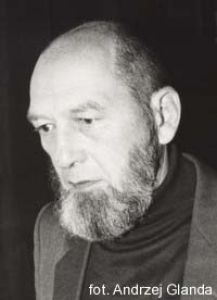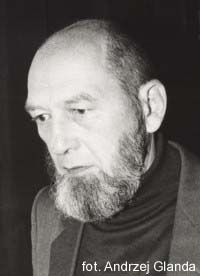Penherski Zbigniew
-
composer
composer; b. 26 January 1935 in Warsaw, d. 4 February 2019 in Warsaw. He studied composition with Stefan Bolesław Poradowski at the State Higher School of Music in Poznań (1955-56) and with Tadeusz Szeligowski at the State Higher School of Music in Warsaw (1956-59), where he later studied conducting with Bohdan Wodiczko (1960-63). As a scholarship holder of the Dutch Government, he also studied at the Institute of Sonology in Utrecht (1969).
Penherski's music was performed in Poland and abroad, including Austria, Belgium, Denmark, France, the Netherlands, Korea, Mexico, Germany, Norway, the United States, Great Britain, Italy, and the former Soviet Union.
He was a prize winner of composition competition such as: Youth Competition of the Polish Composers' Union (1960) for Ostinati, Grzegorz Fitelberg Competition (1964) for Musica humana; Artur Malawski Competition (1976) for Masurian Chronicles II; Composing Competition in Gdansk (1992) for Cantus; Polish Radio Competition (1995) for Genesis. His Little Music for the End of century (1999) was recommended by the International Composers' Tribune in Paris (2001).
In 2013, a CD of Penherski's music was released in the series "Polish Music Today – Portraits of Contemporary Polish Composers", published by the Polish Composers' Union / Polish Music Information Centre POLMIC in cooperation with the Polish Radio and with the support of the Ministry of Culture and National Heritage.
He was a member of Polish Composers' Union (since 1959), Association of Authors ZAIKS (since 1961), Polish Contemporary Music Association, and Warsaw Music Society. He was also an honorary member of the Scottish Society of Composers (1987) and an honorary citizen of Kragujevac in Serbia, Russe in Bulgaria, and Ho-Chi-Minh in Vietnam.
Zbigniew Penherski received the Silver Cross of Merit (1975) and the Award of the Prime Minister of Poland for works for children and youth (1982), as well as the Annual Award of the Polish Composers' Union for outstanding compositional creativity and artistic independence (2015).
updated: 2019 (ac)
Creation
Penherski's work consists predominantly of orchestral and chamber music, radio works, and operas. The most important compositions include: Musica humana for baritone solo, mixed choir and symphony orchestra (1963), Street Music [Muzyka uliczna] for chamber ensemble (1966), opera The Twilight of Peryn [Zmierzch Peryna] (1972), Masurian Chronicles II [Kroniki Mazurskie II] for symphony orchestra and tape (1973), String Play for string orchestra (1980), opera Edgar - the Son of Walpor [Edgar - syn Walpora] (1982), Scottish Chronicles [Kroniki Szkockie] for symphony orchestra (1987), Little Music for the End of Century [Muzyczka na koniec wieku] for recorder, two percussions, organ and tape (1999).
His personality is very expressive and strong. His perception of world events and art is higly indyvidual, natural and modest, colored by great expressiveness and sensitivity, while at the same time bearing markings of reserve, sarcasm and irony against being pompous, artificial and pretentious. These characteristics account for his reluctance to mimic in his works any fashionable currents and aestetic tendencies, as well as for his focus on his own aestetic and technical solutions, to express his individual artistic credo and philosophy of life. From these arise his interest in exoticism as a potential source of inspiration, facilitating departure from eclectic activities. It results in a certain isolation from the main trends of music, not striving for fame and popularity, but focusing on matters that the composer deems vital to himself and his creations. Penherski composes music full of contrasts, saturated with expression and color. One of the typical features of his music is the manifestation of "pure form".
Quote from an interview:
I belive that I have not, in any of my pieces, reffered to forms that used to be valid in the past, either to sonata, rondo, or others. Form is extremely important to me, but it is always my own form. If I were to look for references, I would refer to architecture and mathematics.
In shaping the form, a particular significance is gained by the rule of gradation, namely development of the score from the state of nearly nonexistence, through gradual intensification of sound, to culmination, frequently broken rapidly. Hence, noticeable are the composr's predilections for arch form, often constructed with an almost mathematical precision (Radio Symphony [Symfonia radiowa], Signals [Sygnaly], Little String Litany [Mala litania smyczkowa]). Sometimes the form is enriched with elements of "happening", which, however, are not supposed to entertain its listener, but to emphasize the structure of the music (Incantationi I, Instrumental quartet [Kwartet instrumentalny]). For example, Incantationi I starts with only one performer, with the other musicians gradually joining in. The piece ends in similiar pattern: musicians leave the stage, everything dies away and the last performer drops a ping-pong ball, which bouncing, taps a rhythm of natural "morendo". In a number of his pieces the composer employs programmatic titles, but he treats the titles as a type of addition to the musical content. For instance, the title String Play could be understood as a purely musical idea or as a term of multiple meanings, which are evoked by the word "play" in informal language. String Play deserves even more attention as an instant of an indyvidual view at the non-traditional organization of movement. The introduction of the metronome is designed to control the pace of a few different layers of sound, combined with one another. As the composer said: "It is my approach to a kind of aleatorism, absolutely controlled". The aleatorism understood in this way appears for the first time in Penherski's radio opera The Trial of Samson [Sad nad Samsonem], and subsequently in Instrumental quartet, Radio Symphony, chamber opera Island of Roses [Wyspa róż], Introduction and Genesis.
Quote from an interview:
I do not rally belive in aleatorism. I think that, by leaving too much freedom to performers (in an extreme case for the full utilization of graphic transcript!), it may lead either to very good results, or, unforunately very frequently, to results having nothing or very little to do with composer's idea. The later case is usually a consequwnce of the lack of ability or the lack of good will on the part of the performer. In order to avoid such unfortunate misunderstandings, I prefer to use relatively simple overlapping of various tempos.
A feature of Penherski's music is sonorous ingenuity and refinement. It expands zones of humming not so much by preparation of instruments, but by employing atypical technics and articulation. Multidirectional sonorous penetrations manifest themselves in his unique predilection for percussion ( Scottish Chronicles, Three recitatives for soprano, piano and percussion [Trzy recytatywy na sopran, fortepian i perkusje]. The language employed by the composer is always consequently modern, free of postmodernist references.
Quote from an interview:
All these musical currents like neoclassicism, neoromanticism, have never been of interest to me. I think, my first compositions are stylistically almost the same as the most recent ones. I have tried to develop my own language, and I belive I have been loyal to it.
A separate group of compositions consists of those created for radio, and resulting from many years of collaboration of the composer with the Polish Radio ( opera The Trial of Samson, Radio Symphony, Opera etude [Etiuda operowa], Genesis). This form allows for the use of various techniques, differing from those typically achived electronically, "studio-like".
Quote from an interview:
What is attractive in radio technique is that I may employ ways of production which on stage may be troublesome, and even difficult for performers. Although the use of four metronomes in Instrumantal quartet was relatively easy, the three metronomes in String Play needed to be put in such a way, that the tempo would be set by the visible movement of the pendlums, not the ticking sound ( in newer metronomes it would have to be a light signal). Hence, my tendency for resorting to radio-studio techniques, allowing to use sound, which while being conventional (i.e. not electronic), departs from the typically European traditions, both in aspect of rhythmicity and structure.
Penherski's music does not try to be grand, pathetic, and does not intend to awaken the greatest emotion. The composer does not employ grand themes, rich in various extra-musical references to national or universal values, He sets himself simpler challenges. The composer wants, most of all, to awake the interest of his listener, using purely musical means, with the aid of original organization of sound and of forms suggesting a certain plot. It presents the world as seen through the eyes of an uncompromising artist, who measures and evaluates the means employed in such a way that they agree with his own vision of the secret of entity and art.
(Marek Podhajski)
Compositions
Two Lullabies for mezzo-soprano and piano (1955)
Three Songs for soprano and piano (1955)
Four Preludes for piano (1956)
Ostinati for mixed choir and orchestra (1960)
Choral Pictures for mixed choir (1960)
Studies in Colour for piano (1961)
Three Gipsy Songs for three-part women choir, to the texts by J. Ficowski (1961)
Three Songs to Old Polish Texts for mixed choir (1961)
Contrasts for string orchestra, selected instruments and vocal ensemble (1962)
Musica humana for baritone solo, mixed choir and symphony orchestra, to the texts from the Bible [Latin] (1963)
Three Recitatives for soprano, piano and percussion (1963)
Suite for oboe and piano (1963)
Chamber Alphabet Book, 6 cyclic pieces for various ensembles (1964)
Missa Abstracta for tenor solo, reciting voice, mixed choir and symphony orchestra, to the texts from the Bible [Latin] and by T. Różewicz (1966)
Street Music for chamber ensemble (1966)
Samson Put on Trial, radio opera. Libretto by J. Prutkowski (1967)
Three Recitatives for soprano, piano and percussion [new version] (1968)
3M-HI for tape (1969)
Children’s Improvisations for instrumental ensembles (1969)
Hymnus laudans for choir and chamber orchestra, to the texts of medieval hymns (1970)
Instrumental Quartet for piano (or other keyboard instrument) and 3 optional instruments (1970)
Incantationi I for 6 percussionists (1972)
The Twilight of Peryn, opera (1972)
Masurian Chronicles for symphony orchestra and tape (1973)
Anamnesis for symphony orchestra (1975)
Radio Symphony for 2 performers, for tape (1975)
String Play for string orchestra (1980)
Edgar – the Son of Walpor, opera. Libretto by composer after the drama of S. I. Witkiewicz (1982)
Jeux parties for saxophone and percussion (1984)
Three Impressions for soprano, piano and 4 percussionists (1985)
Scherzino for four violins (1985)
Scottish Chronicles for symphony orchestra (1987)
The Island of the Roses, chamber opera. Libretto by K. Meissner (1989)
Three Songs for Children for two- or three-part choir (1990)
Signals for symphony orchestra (1992)
Cantus for mixed choir, to the texts from the Bible (1992)
Introduction and Toccata for clarinet, trombone, cello and piano (1994)
Genesis for bass solo, vocal ensembles, reciting voices, selected instruments, concrete and electronic sounds (1995)
Signals II for symphony orchestra (1995)
Intrada for symphony orchestra (1995)
Four Easy Pieces for piano (1997)
Lyric Waltz for street bells, flute, three trumpets and two percussionists (1998)
Scherzino for street bells, flute, clarinet, three trumpets and two percussionists (1998)
Toccata for clarinet, trombone, cello and piano (1998)
Little Music for the End of Century for recorder, organ, two percussionists and tape (1999)
X-Play for orchestra of 30 flutes (1999)
Let cellos play for 8 cellos (1999)
Little Suite in Old-Fashioned Style for chamber string orchestra (1999, 2007)
Cantus II for mixed a cappella choir (2000)
Little March for piano, for 4 hands (2000 )
Das Wohlpentatonierte Klavier - Scherzo for piano (2000 )
Impressions on a Theme of B-A-C-H for piano (2000 )
Dance for three recorders (2001 )
Little String Litany for chamber string orchestra
(2002)Lamentations for baritone or male soprano and string quaret to selected fragments from the Book of Jeremiah (2003)
Four Psalms for mixed a cappella choir (2005)
Little String Chronicles for string orchestra (2005)
Little "Autumn" Symphony (2006)
Lamentacje na baryton lub sopran męski i kwartet smyczkowy do wybranych fragmentów Księgi Jeremiasza (2010)
Brewiarz na sopran męski i kwartet smyczkowy do słów Zbigniewa Herberta (2012)
Cztery utwory bez słów na chór mieszany a cappella (2014)
Mała litania 2 na orkiestrę kameralną (2016)
Literature
Chomiński Józef, The Music of Polish People’s Republic [Muzyka Polski Ludowej], PWN, Warszawa 1968
Hanuszewska Mieczysława, Schaeffer Bogusław, Almanac of Present Polish Composers [Almanach polskich kompozytorów współczesnych], PWM, Kraków 1982
Polish Opera and Ballet of the Twentieth Century, PWM, Kraków 1986
Who is Who in Poland, Interpress, Warszawa 1989











